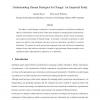Free Online Productivity Tools
i2Speak
i2Symbol
i2OCR
iTex2Img
iWeb2Print
iWeb2Shot
i2Type
iPdf2Split
iPdf2Merge
i2Bopomofo
i2Arabic
i2Style
i2Image
i2PDF
iLatex2Rtf
Sci2ools
109
click to vote
TARK
2005
Springer
2005
Springer
Understanding human strategies for change: an empirical study
The ability to model changes in preferences is crucially important for sound decision making and effective communication. Much has been written about strategies for changing beliefs and preferences. Typically such strategies have been driven by theoretical considerations, intuitive notions of rationality, and an appeal to the principle of Minimal Change. In this paper we describe an experiment in which people were asked to rank information, then given some new information, and asked to re-rank the information. We analyse the results and provide comparisons with some well known computational strategies. Some of the results are surprising, for example, a large percentage of human strategies can be classified as either Conditionalization, Adjustment, or a combination.
Related Content
| Added | 28 Jun 2010 |
| Updated | 28 Jun 2010 |
| Type | Conference |
| Year | 2005 |
| Where | TARK |
| Authors | Alankar Karol, Mary-Anne Williams |
Comments (0)

